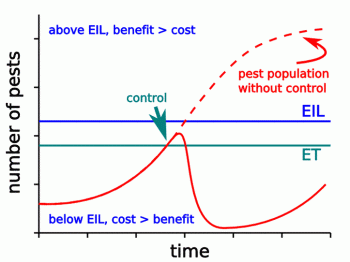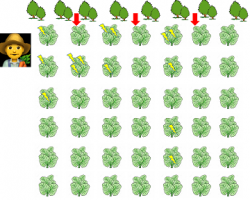
Pest Scouting and Using the UMass Scouting Sheets
Scouting is the process of routinely checking crops for pests and disease to inform management decisions. The idea is to regularly check a random sample of plants across a field to get a sense of what pests are present and in what quantities, how widespread the problem is, and to identify any patterns in distribution so that you can decide whether or not it’s time to implement a control strategy. It’s often a good idea to get into the field and see for yourself what’s happening when a pest has been detected on or near your farm, or when monitoring data or environmental conditions indicate that a particular pest may be emerging. Successfully implementing IPM requires that you are aware of the conditions on and around your farm each year and over time. Furthermore, establishing a scouting program can help you keep track of what you see and allow you to detect pest problems early and prevent and manage issues before they cause economic losses. Regular scouting will also help you determine whether your spray program and other control strategies are effective, as you can see pest numbers going up or down over time. The UMass Vegetable Program has developed a series of crop-specific scouting sheets, linked below, to help you keep track of your scouting and make decisions about what you find!
Some things to consider before you go into the field:
Field history
What crop or crop family was planted here last year and what pest issues were there? Consider insect pests, but also diseases that might persist in soil or on crop residues, and weeds. Also note locations of field edges, as pests may emerge from windrows, woods, or adjacent fields. Note shaded areas or places with poor drainage.
Pest identification
Know what you’re looking for! It’s important to be able to identify some of the key insects that may be feeding on your crop and to be able to tell the good bugs from the bad. You should also be able to recognize some of the signs and symptoms of insect feeding, and common diseases and physiological disorders. There are lots of great ID guides out there, including the Northeast Vegetable & Strawberry Pest Identification Guide—a collaborative effort of the New England Extensions. It can be very tricky to identify problems in the field, though, so if you find something suspect, consider having it diagnosed at the UMass Plant Diagnostic Lab, or testing soil or plant tissues for nutrients at the UMass Soil and Plant Tissue Testing Lab.
Pest life cycles
Consider when certain pests are active and if they overwinter or persist in the environment, or if they have to travel from warmer locations on storm fronts. Pheromone traps, sticky cards, keeping track of growing degree days (GDDs), and using web-based monitoring tools can all help with knowing when to keep an eye out for particular insects and/or diseases. It’s also important to know what the different life stages of insect pests look like, where you might find them, and which stage(s) will harm your crop.
Economic threshold and economic injury level
 The economic threshold is the pest population size or the level of damage that a crop can tolerate without economic impact. When the threshold is reached, some control should be implemented. The economic injury level is that point above which crop yield will be affected by pest damage, and the benefit of controlling the pest outweighs the cost. Often, thresholds have been established through scientific research. You may develop your own thresholds based on your scouting records and trends on your own farm, as well as what your markets may tolerate. Shareholders of a CSA may be more tolerant of some insect feeding than a high-end restaurant, for instance.
The economic threshold is the pest population size or the level of damage that a crop can tolerate without economic impact. When the threshold is reached, some control should be implemented. The economic injury level is that point above which crop yield will be affected by pest damage, and the benefit of controlling the pest outweighs the cost. Often, thresholds have been established through scientific research. You may develop your own thresholds based on your scouting records and trends on your own farm, as well as what your markets may tolerate. Shareholders of a CSA may be more tolerant of some insect feeding than a high-end restaurant, for instance.
Management options
What pesticide options and other control strategies do you have available and how effective are they? Your economic threshold may be lower than those published if you are using organic materials since economic thresholds are designed with conventional pesticides in mind and many organic materials are less effective than conventional materials. Or you may not have an effective control option for a current pest problem, but scouting and keeping records will help you prevent problems in the future by using crop rotations, row covers, or materials applied at-planting. Have some sense of what you will do with the information you collect.
Now to scouting!
The idea here is to assess a random sample of plants that is representative of what is happening in the whole field or crop, or to identify hot spots or problem areas in the field or among different crops or varieties. Don’t make spray decisions based on what you see on the first couple of plants in your sampling! You might panic because the first plant is covered in beetles, but then realize that the problem is localized and that the crop as a whole is well below threshold (Figs. 2 and 3).
First, take a look at the field as a whole and note if anything looks abnormal. Then, decide how you will divide the field into units. If you plan to look at 25 plants, decide about how frequently you would have to stop to get a sampling of the entire field.
Please see our Scouting Resources page for the scouting forms we currently have available.
Each sheet has a list of common pests, thresholds if available, along with some sampling instructions. Thresholds or control options may vary depending on the stage of the crop, so there is a place to note that as well. For example, in potato, you should scout 3 plants per site when the crop is small or 3 individual stalks once the plants are hilled. Note the unit you are using and what the threshold is.
Using the appropriate scouting sheet for the crop you are inspecting, move through the field, stopping at random spots—moving in a V or W pattern works best—and look at whatever plant(s) happen to be wherever you stop. It helps to count about the same number of paces between samples so that you avoid getting a biased sample by inadvertently stopping at plants that are obviously affected or infested. Look at and around the plant, then inspect more closely—pests and symptoms can often be found on the undersides of leaves or on stems. It’s good to have a hand lens with you for looking at small insects or mysterious lesions. Record what you see in the appropriate line on the scouting sheet, along with any notes you think are important. There is a spot on the sheets labeled ‘scouting map’ so you can record your path. This may reveal that there is higher pressure on one area of the field, which can indicate where a pest is entering, or a preference for a certain variety.
When you have finished sampling, count your results. Take the average for whatever unit you are considering for your threshold—it may be insects per leaf or damage per plant—and compare that number to your threshold. If you are above the threshold, apply your control strategy. If you are below, wait to treat and scout again at some regular interval (e.g. the following week). If you implement a control, scout again afterward to determine if the treatment worked and when/if you should make another application. If you found natural enemies when scouting, consider them when deciding which material to use or whether a pesticide application is warranted.
Using these scouting sheets throughout the season and over multiple years can help you to identify trends and understand your pest levels and cycles and the effectiveness of your management strategies over time. If you do use the UMass scouting sheets, we’d love your feedback! Let us know if they help you manage your scouting program, and if you have suggestions for how they can be improved. Contact us at 413-577-3976 or umassvegetable@umext.umass.edu.
We also have more detailed scouting guides for sweet corn and cucurbits:
Cucurbit Disease Scouting and Management Guide
The Center for Agriculture, Food and the Environment and UMass Extension are equal opportunity providers and employers, United States Department of Agriculture cooperating. Contact your local Extension office for information on disability accommodations. Contact the State Center Director’s Office if you have concerns related to discrimination, 413-545-4800 or see ag.umass.edu/civil-rights-information.

